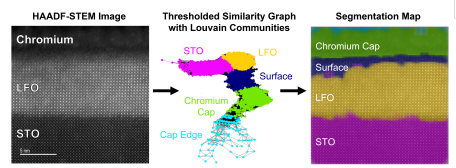2024-03-21 パシフィック・ノースウェスト国立研究所(PNNL)
<関連情報>
- https://www.pnnl.gov/news-media/new-ai-model-leap-autonomous-materials-science
- https://arxiv.org/abs/2311.08585
電子顕微鏡における照射誘起秩序-無秩序相転移の教師なしセグメンテーション Unsupervised segmentation of irradiation‐induced order‐disorder phase transitions in electron microscopy
Arman H Ter-Petrosyan, Jenna A Bilbrey, Christina M Doty, Bethany E Matthews, Le Wang, Yingge Du, Eric Lang, Khalid Hattar, Steven R Spurgeon
arXiv Submitted on:14 Nov 2023
DOI:https://doi.org/10.48550/arXiv.2311.08585

Abstract
We present a method for the unsupervised segmentation of electron microscopy images, which are powerful descriptors of materials and chemical systems. Images are oversegmented into overlapping chips, and similarity graphs are generated from embeddings extracted from a domain‐pretrained convolutional neural network (CNN). The Louvain method for community detection is then applied to perform segmentation. The graph representation provides an intuitive way of presenting the relationship between chips and communities. We demonstrate our method to track irradiation‐induced amorphous fronts in thin films used for catalysis and electronics. This method has potential for “on‐the‐fly” segmentation to guide emerging automated electron microscopes.



